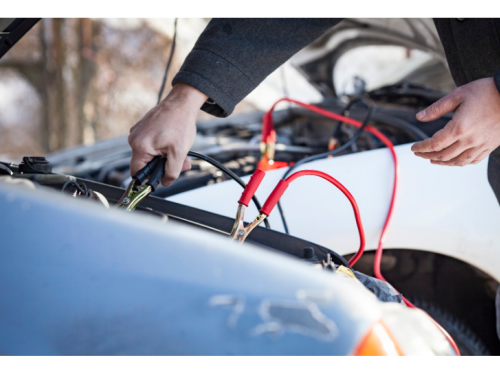If your engine won’t turn over, one of the most likely reasons is a flat battery. Dead batteries can be caused by a number of things, including headlights that have been left running, a door that hasn’t been shut properly or simply the battery’s age. This is why it’s important to carry out certain safety checks regularly, especially during the winter months.
In most cases, your car can be restarted by jump-starting the battery using electrical power from another vehicle and jump leads. Below, we’ve laid out the steps you should take to get back on the road.

How to jumpstart a car with leads
To jumpstart your car with leads, you’ll need access to a second vehicle that has a fully charged battery. Avoid using a hybrid or electric car to do this, as their batteries are different to those in a petrol or diesel vehicle. You will also need a pair of jump leads. It’s always worth buying a pair and keeping them stored in your car in case you or someone else ever needs them.
First, you should check the battery for any sign of damage. If you can see obvious damage on the battery or the jump leads, then don’t attempt to jumpstart the vehicle. You might also want to remove any rings or other jewellery that you’re wearing and ensure that no metal touches the terminal on the battery. Then, follow the below.
- Step 1: Ensure that all electrical devices in the vehicle are switched off. This includes the lights, radio and sat-nav.
- Step 2: Park the second vehicle as close to your car as you can without the two actually touching. The jump leads shouldn’t be stretched or taut – they should plug in to each vehicle easily with enough slack.
- Step 3: Turn off the engines of both cars, remove the keys and open the bonnets.
- Step 4: Plug one end of the red jump lead into the positive terminal of the flat battery. The positive terminal is usually identifiable by a plus symbol.
- Step 5: Plug the other end of the lead into the positive terminal in the second vehicle.
- Step 6: Repeat Step 4 with the black lead, plugging it into the negative battery terminal in the second vehicle.
- Step 7: With the other end of the black lead, place it on any metal part of the engine in the car that has a flat battery. This creates an earthing point.
- Step 8: Turn on the engine of each vehicle one at a time, starting with the second car. Leave both vehicles running for a minimum of five minutes.
- Step 9: If the above steps don’t resolve the issue, the vehicle could have a more serious problem than a flat battery. If you have breakdown cover, you should call a professional to take a look or tow the car to your local garage.
Once you’ve got the vehicle started again, you need to disconnect the jump leads. To do this safely, turn off the engines in both vehicles then disconnect the black lead from the first vehicle and then from the second vehicle. Next, remove the red lead first from the second vehicle and then from your own car.
This process is meant to be a temporary measure that will get you home, however you shouldn’t continue to drive without fully charging the battery, as it will likely run out again. The battery should be charged using a charger that can be plugged into the mains.
Can you jumpstart an automatic car?
The procedure to jumpstart an automatic car is the same as with a manual one, so follow the steps we’ve outlined above.
What should I do if my car breaks down?
It isn’t a huge emergency if your battery won’t start – it’s an inconvenience but as long as you’re parked in a safe place, there shouldn’t be too many issues getting back on the road.
Breaking down is a different matter altogether. If you’re driving and your engine has failed, you need to pull over quickly to a safe spot, preferably away from other vehicles, and put your hazard warning lights on. Exit the vehicle, particularly if you’re on a dangerous road such as a motorway, and wait a short distance away until the breakdown vehicle arrives.
You should use a mobile phone to contact your breakdown company. If your phone has died or you have no signal, you could borrow the mobile of another person. Alternatively, if you’re on the motorway, you could use the emergency phone that should be located along the hard shoulder. This will go straight through to the police or the Highways Agency.
You should check that your vehicle is safe to drive before setting off again.
